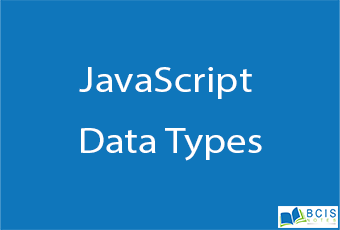
JavaScript Data Types
There are six basic data types in JavaScript which can be divided into three main categories: primitive (or primary), composite (or reference), and special data types. String, Number, and Boolean are primitive data types. Object, Array, and Function (which are all types of objects) are composite data types whereas Undefined and Null are special data types.
The String Data Type
The string data type is used to represent textual data (i.e. sequences of characters). Strings are created using single or double quotes surrounding one or more characters, as shown below:
var a = ‘Hi there!’; // using single quotes
var b = “Hi there!”; // using double quotes
You can include quotes inside the string as long as they don’t match the enclosing quotes.
var a = “Let’s have a cup of coffee.”; // single quote inside double quotes
var b = ‘He said “Hello” and left.’; // double quotes inside single quotes
var c = ‘We\’ll never give up.’; // escaping single quote with backslash
The Number Data Type
The number data type is used to represent positive or negative numbers with or without decimal place, or numbers are written using exponential notation e.g. 1.5e-4 (equivalent to 1.5×10-4).
var a = 25; // integer
var b = 80.5; // floating-point number
var c = 4.25e+6; // exponential notation, same as 4.25e6 or 4250000
var d = 4.25e-6; // exponential notation, same as 0.00000425
The Number data type also includes some special values which are: Infinity, -Infinity and NaN. Infinity represents the mathematical Infinity ∞ , which is greater than any number. Infinity is the result of dividing a nonzero number by 0, as demonstrated below:
alert(16 / 0); // Output: Infinity
alert(-16 / 0); // Output: -Infinity
alert(16 / -0); // Output: -Infinity
While represents a special Not-a-Number value. It is a result of an invalid or an undefined mathematical operation, like taking the square root of -1 or dividing 0 by 0,
alert(“Some text” / 2); // Output: NaN
alert(“Some text” / 2 + 10); // Output: NaN
alert(Math.sqrt(-1)); // Output: NaNc.
The Boolean Data Type
The Boolean data type can hold only two values: true or to store values like yes (true) or no (false), on (true) or off ( demonstrated below:
var isReading = true; // yes, I’m reading
var isSleeping = false; // no, I’m not sleeping
Boolean values also come as a result of comparisons in a program. The following example compares two variables and shows the result in an alert dialog box:
var a = 2, b = 5, c = 10;
alert(b > a) // Output: true
alert(b > c) // Output: false
The Undefined Data Type
The undefined data type can only have one value-the special value undefined. If a variable has been declared but has not been assigned a value, has the value undefined.
var a;
var b = “Hello World!”
alert(a) // Output: undefined
alert(b) // Output: Hello World!
The Null Data Type
This is another special data type that can have only one value-the null value. A null value means that there is no value. It is not equivalent to an empty string (“”) or 0, it is simply nothing.
A variable can be explicitly emptied of its current contents by assigning it the null value.
var a = null;
alert(a); // Output: null
var b = “Hello World!”
alert(b); // Output: Hello World!
b = null;
alert(b) // Output: null
The Object Data Type
The object is a complex data type that allows you to store collections of data.
An object contains properties, defined as a key-value pair. A property key (name) is always a string, but the value can be any data type, like strings, numbers, booleans, or complex data types like arrays, function and other objects. The following example will show you the simplest way to create an object in JavaScript.
var emptyObject = {};
var person = {“name”: “Clark”, “surname”: “Kent”, “age”: “36”};
// For better reading
var car = {
“modal”: “BMW X3”,
“color”: “white”, ”
doors”: 5
}
The Array Data Type
An array is a type of object used for storing multiple values in a single variable. Each value (also called an element) in an array has a numeric position, known as its index, and it may contain data of any data type-numbers, strings, booleans, functions, objects, and even other arrays. The array index starts from 0 so that the first array element is arr[0], not arr[1].
The simplest way to create an array is by specifying the array elements as a comma-separated list enclosed by square brackets, as shown in the example below:
var colors = [“Red”, “Yellow”, “Green”, “Orange”];
var cities = [“London”, “Paris”, “New York”];
alert(colors[0]); // Output: Red
alert(cities[2]); // Output: New York
The Function Data Type
A function is a callable object that executes a block of code. Since functions are objects, so it is possible to assign them to variables, as shown in the example below:
var greeting = function(){
return “Hello World!”;
}
// Check the type of greeting variable
alert(typeof greeting) // Output: function
alert(greeting()); // Output: Hello World!
If you liked our content JavaScript Data Types, then you will also like JavaScript Syntax

Leave a Reply